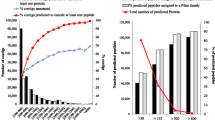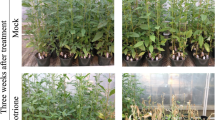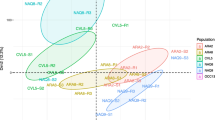Abstract
Non-target-site resistance (NTSR) to herbicides that disrupts agricultural weed control is a worldwide concern for food security. NTSR is considered a polygenic adaptive trait driven by differential gene regulation in resistant plants. Little is known about its genetic determinism, which precludes NTSR diagnosis and evolutionary studies. We used Illumina RNA-sequencing to investigate transcriptomic differences between plants from the global major weed rye-grass sensitive or resistant to the acetolactate-synthase (ALS) inhibiting herbicide pyroxsulam. Plants were collected before and along a time-course after herbicide application. De novo transcriptome assembly yielded a resource (LOLbase) including 92,381 contigs representing potentially active transcripts that were assigned putative annotations. Early effects of ALS inhibition consistent with the literature were observed in resistant and sensitive plants, proving LOLbase data were relevant to study herbicide response. Comparison of resistant and sensitive plants identified 30 candidate NTSR contigs. Further validation using 212 plants resistant or sensitive to pyroxsulam and/or to the ALS inhibitors iodosulfuron + mesosulfuron confirmed four contigs (two cytochromes P450, one glycosyl-transferase and one glutathione-S-transferase) were NTSR markers which combined expression levels could reliably identify resistant plants. This work confirmed that NTSR is driven by differential gene expression and involves different mechanisms. It provided tools and foundation for subsequent NTSR investigations.








Similar content being viewed by others
References
Alexa A, Rahnenfuhrer J, Lengauer T (2006) Improved scoring of functional groups from gene expression data by decorrelating GO graph structure. Bioinformatics 22:1600–1607
Anders S, Huber W (2010) Differential expression analysis for sequence count data. Genome Biol 11:R106
Baker HG (1974) The evolution of weeds. Annu Rev Ecol Syst 5:1–24
Beckie HJ, Tardif FJ (2012) Herbicide cross resistance in weeds. Crop Prot 35:15–28
Briske DD (1991) Developmental morphology and physiology of grasses. In: Heitschmidt RK, Stuth JW (eds) Grazing management: an ecological perspective. Timber Press, Portland, pp 85–108
Burke GR, Strand MR (2012) Deep sequencing identifies viral and wasp genes with potential roles in replication of Microplitis demolitor bracovirus. J Virol 86:3293–3306
Busi R, Vila-Aiub MM, Powles SB (2011) Genetic control of a cytochrome P450 metabolism-based herbicide resistance mechanism in Lolium rigidum. Heredity 106:817–824
Busi R, Neve P, Powles S (2013) Evolved polygenic herbicide resistance in Lolium rigidum by low-dose herbicide selection within standing genetic variation. Evol Appl 6:231–242
Carels N, Bernardi G (2000) Two classes of genes in plants. Genetics 154:1819–1825
Charmet G, Balfourier F, Chatard V (1996) Taxonomic relationships and interspecific hybridization in the genus Lolium (grasses). Genet Resour Crop Evol 43:319–327
Cummins I, Cole DJ, Edwards R (1999) A role for glutathione transferases functioning as glutathione peroxidases in resistance to multiple herbicides in black-grass. Plant J 18:285–292
Cummins I, Bryant DN, Edwards R (2009) Safener responsiveness and multiple herbicide resistance in the weed black-grass (Alopecurus myosuroides). Plant Biotechnol J 7:807–820
Cummins I, Wortley DJ, Sabbadin F, He ZS, Coxon CR, Straker HE, Sellars JD, Knight K, Edwards L, Hughes D et al (2013) Key role for a glutathione transferase in multiple-herbicide resistance in grass weeds. Proc Natl Acad Sci USA 110:5812–5817
Das M, Reichman JR, Haberer G, Welzl G, Aceituno FF, Mader MT, Watrud LS, Pfleeger TG, Gutierrez RA, Schaffner AR, Olszyk DM (2010) A composite transcriptional signature differentiates responses towards closely related herbicides in Arabidopsis thaliana and Brassica napus. Plant Mol Biol 72:545–556
Délye C (2013) Unravelling the genetic bases of non-target-site-based resistance (NTSR) to herbicides: a major challenge for weed science in the forthcoming decade. Pest Manag Sci 69:176–187
Délye C, Boucansaud K, Pernin F, Le Corre V (2009) Variation in the gene encoding acetolactate-synthase in Lolium species and proactive detection of mutant, herbicide-resistant alleles. Weed Res 49:326–336
Délye C, Jasieniuk M, Le Corre V (2013) Deciphering the evolution of herbicide resistance in weeds. Trends Genet 29:649–658
Duhoux A, Délye C (2013) Reference genes to study herbicide stress response in Lolium sp.: up-regulation of P450 genes in plants resistant to acetolactate-synthase inhibitors. PLoS ONE 8:e63576
Egan AN, Schlueter J, Spooner DM (2012) Applications of next-generation sequencing in plant biology. Am J Bot 99:175–185
Fan HK, Xiao Y, Yang YD, Xia W, Mason AS, Xia ZH, Qiao F, Zhao SL, Tang HR (2013) RNA-Seq analysis of Cocos nucifera: transcriptome sequencing and de novo assembly for subsequent functional genomics approaches. PLoS ONE 8:e59997
Farrell JD, Byrne S, Paina C, Asp T (2014) De novo assembly of the perennial ryegrass transcriptome using an RNA-Seq strategy. PLoS ONE 9:e103567
Finn RD, Clements J, Eddy SR (2011) HMMER web server: interactive sequence similarity searching. Nucleic Acids Res 39:W29–W37
Gaines TA, Lorentz L, Figge A, Herrmann J, Maiwald F, Ott MC, Han H, Busi R, Yu Q, Powles SB, Beffa R (2014) RNA-Seq transcriptome analysis to identify genes involved in metabolism-based diclofop resistance in Lolium rigidum. Plant J. doi:10.1111/tpj.12514
Gouzy J, Carrère S, Schiex T (2009) FrameDP: sensitive peptide detection on noisy matured sequences. Bioinformatics 25:670–671
Heap I (2014) International survey of herbicide-resistant weeds. [WWW document]. http://www.weedscience.org. Accessed 31 July 2014
Huang XQ, Madan A (1999) CAP3: a DNA sequence assembly program. Genome Res 9:868–877
Humphreys J, O’Kiely P (2006) Amount and quality of grass harvested for first-cut silage for differing spring-grazing frequencies of two mixtures of perennial ryegrass cultivars with contrasting heading date. Grass Forage Sci 61:77–88
Iwakami S, Uchino A, Kataoka Y, Shibaike H, Watanabe H, Inamura T (2014) Cytochrome P450 genes induced by bispyribac-sodium treatment in a multiple-herbicide-resistant biotype of Echinochloa phyllopogon. Pest Manag Sci 70:549–558
Li JY, Mu JY, Bai JT, Fu FY, Zou TT, An FY, Zhang J, Jing HW, Wang Q, Li Z, Yang S, Zuo J (2013) PARAQUAT RESISTANT1, a Golgi-localized putative transporter protein, is involved in intracellular transport of paraquat. Plant Physiol 162:470–483
Manabe Y, Tinker N, Colville A, Miki B (2007) CSR1, the sole target of imidazolinone herbicide in Arabidopsis thaliana. Plant Cell Physiol 48:1340–1358
Martin JA, Wang Z (2011) Next-generation transcriptome assembly. Nat Rev Genet 12:671–682
Mortazavi A, Williams BA, McCue K, Schaeffer L, Wold B (2008) Mapping and quantifying mammalian transcriptomes by RNA-Seq. Nat Methods 5:621–628
Oerke EC (2006) Crop losses to pests. J Agr Sci 144:31–43
Orcaray L, Igal M, Marino D, Zabalza A, Royuela M (2010) The possible role of quinate in the mode of action of glyphosate and acetolactate synthase inhibitors. Pest Manag Sci 66:262–269
Orcaray L, Igal M, Zabalza A, Royuela M (2011) Role of exogenously supplied ferulic and p-coumaric acids in mimicking the mode of action of acetolactate synthase inhibiting herbicides. J Agric Food Chem 59:10162–10168
Ozsolak F, Milos PM (2011) RNA sequencing: advances, challenges and opportunities. Nat Rev Genet 12:87–98
Petit C, Pernin F, Heydel JM, Délye C (2012) Validation of a set of reference genes to study response to herbicide stress in grasses. BMC Res Notes 5:18
Quevillon E, Silventoinen V, Pillai S, Harte N, Mulder N, Apweiler R, Lopez R (2005) InterProScan: protein domains identifier. Nucleic Acids Res 33:W116–W120
Saika H, Horita J, Taguchi-Shiobara F, Nonaka S, Nishizawa-Yokoi A, Iwakami S, Hori K, Matsumoto T, Tanaka T, Itoh T, Yano M, Kaku K, Shimizu T, Toki S (2014) A novel rice cytochrome P450 gene, CYP72A31, confers tolerance to acetolactate synthase-inhibiting herbicides in rice and Arabidopsis. Plant Physiol. doi:10.1104/pp.113.231266
Trenkamp S, Eckes P, Busch M, Fernie AR (2009) Temporally resolved GC-MS-based metabolic profiling of herbicide treated plants treated reveals that changes in polar primary metabolites alone can distinguish herbicides of differing mode of action. Metabolomics 5:277–291
Untergasser A, Nijveen H, Rao X, Bisseling T, Geurts R, Leunissen JAM (2007) Primer3Plus, an enhanced web interface to Primer3. Nucleic Acids Res 35:W71–W74
Vigueira CC, Olsen KM, Caicedo AL (2013) The red queen in the corn: agricultural weeds as models of rapid adaptive evolution. Heredity 110:303–311
Ward JA, Ponnala L, Weber CA (2012) Strategies for transcriptome analysis in nonmodel plants. Am J Bot 99:267–276
Werck-Reichhart D, Hehn A, Didierjean L (2000) Cytochromes P450 for engineering herbicide tolerance. Trends Plant Sci 5:116–123
Xu P, Liu Z, Fan X, Gao J, Zhang X, Zhang X, Shen X (2013) De novo transcriptome sequencing and comparative analysis of differentially expressed genes in Gossypium aridum under salt stress. Gene 525:26–34
Yang X, Yu XY, Li YF (2013) De novo assembly and characterization of the barnyardgrass (Echinochloa crus-galli) transcriptome using next-generation pyrosequencing. PLoS ONE 8:e69168
Yuan JS, Tranel PJ, Stewart CN Jr (2007) Non-target-site herbicide resistance: a family business. Trends Plant Sci 12:6–13
Zabalza A, Zulet A, Gil-Monreal M, Igal M, Royuela M (2013) Branched-chain amino acid biosynthesis inhibitors: herbicide efficacy is associated with an induced carbon-nitrogen imbalance. J Plant Physiol 170:814–821
Zerbino DR, Birney E (2008) Velvet: algorithms for de novo short read assembly using de Bruijn graphs. Genome Res 18:821–829
Zhao J, Ohsumi TK, Kung JT, Ogawa Y, Grau DJ, Sarma K, Song JJ, Kingston RE, Borowsky M, Lee JT (2010) Genome-wide identification of polycomb-associated RNAs by RIP-seq. Mol Cell 40:939–953
Zhou Q, Liu W, Zhang Y, Liu KK (2007) Action mechanisms of acetolactate synthase-inhibiting herbicides. Pestic Biochem Physiol 89:89–96
Zulet A, Gil-Monreal M, Villamor JG, Zabalza A, van der Hoorn RAL, Royuela M (2013) Proteolytic pathways induced by herbicides that inhibit amino acid biosynthesis. PLoS ONE 8:e73847
Acknowledgments
We thank Dr Valérie Le Corre (INRA Dijon, France) for assistance in statistical analyses, and Genotoul—Génopôle Toulouse Midi-Pyrénées for allowing access to computational facilities.
Author information
Authors and Affiliations
Corresponding author
Electronic supplementary material
Below is the link to the electronic supplementary material.
Rights and permissions
About this article
Cite this article
Duhoux, A., Carrère, S., Gouzy, J. et al. RNA-Seq analysis of rye-grass transcriptomic response to an herbicide inhibiting acetolactate-synthase identifies transcripts linked to non-target-site-based resistance. Plant Mol Biol 87, 473–487 (2015). https://doi.org/10.1007/s11103-015-0292-3
Received:
Accepted:
Published:
Issue Date:
DOI: https://doi.org/10.1007/s11103-015-0292-3




